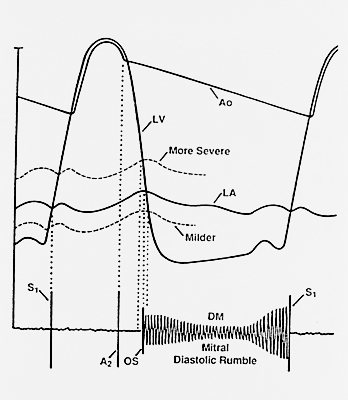
Mitral Valve Stenosis
Mitral stenosis is associated with four auscultatory findings: loud S1, loud P2, an opening snap, and a diastolic murmur. Only the murmur is consistent.
The loudness of S1 and S2 are affected by the patient's body habitus, valve mobility, and pulmonary artery pressure. The still mobile mitral valve that has been damaged by rheumatic fever creates a high frequency sound in early diastole. As left ventricular pressure falls below left atrial pressure, the mitral valve is thrust open. When reaching its maximal excursion due to the limits placed by tethering and fibrosis, the valve comes to a sudden halt. Its thin and relatively inelastic structure creates a high frequency vibration that you can hear best with the diaphragm. The opening snap requires a relatively mobile and non-calcified valve. In many patients with severe and long-standing rheumatic mitral stenosis, calcification of the valve reduces mobility and the OS disappears.

Return to Heart Sounds Podcast Series
Updated August 2009